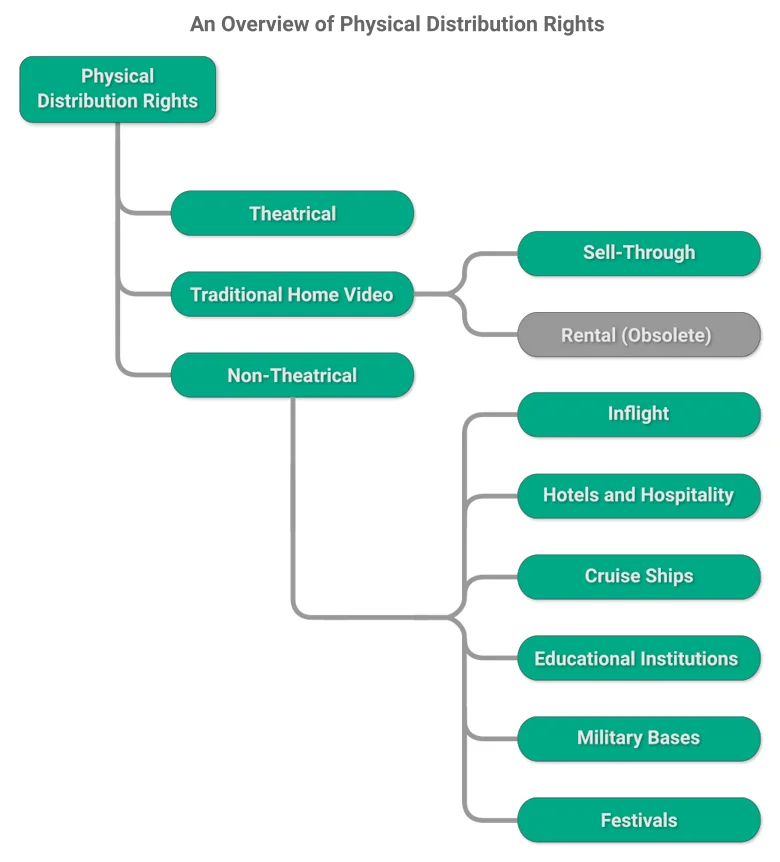A Guide to Traditional and Modern Distribution Rights for Film and TV Content (Part 2)

In the first part of our series on media distribution rights in the film and TV industry, we explored the fundamental concepts of core and ancillary distribution rights. We analyzed how these rights shape the distribution landscape, impacting the visibility and accessibility of content to audiences worldwide. Core distribution rights were identified as the foundational permissions linked to the presentation of a film or TV show, while ancillary distribution rights offer additional avenues for revenue generation. We examined examples of core and ancillary rights and emphasized the importance of understanding distribution rights for both producers and distributors. Continuing our discussion, we now shift our focus to physical distribution rights, which consist of three distinct categories: Theatrical, traditional home video and non-theatrical. Let’s dive into each category to grasp its significance in distribution.
Theatrical Distribution Rights
Theatrical distribution rights serve as the foundation of cinematic experiences, providing audiences with immersive viewing experiences on the silver screen. This category involves partnerships with cinemas and theaters for the public exhibition of films, catering to a communal setting where viewers can collectively engage with the content.
While theatrical releases offer this unique communal experience, it’s essential to recognize that not all products are destined for the big screen. Some productions are specifically tailored for home video or television from the outset, bypassing theatrical release altogether.
For films destined for theatrical release, there are typically two distribution strategies: wide releases and limited releases. Wide releases involve simultaneous screenings in numerous theaters, aiming to reach a broad audience across various locations. In contrast, limited releases target specific markets or demographics initially before gradually expanding to a wider audience.
Revenue generation for theatrical releases primarily stems from box office ticket sales. The success of a film in theaters is often gauged by its opening weekend grosses and per-screen averages, reflecting audience interest and engagement.
Additionally, theatrical release windows play a pivotal role in the distribution process. These windows dictate the duration of exclusive theater screenings before the film becomes available for distribution on other platforms such as home video, television or streaming services.
Overall, while theatrical distribution rights offer filmmakers the opportunity to exhibit their work on the big screen and engage audiences in a communal setting, it’s essential to acknowledge the diversity of distribution strategies within the film industry, with some productions finding their place in home video or television markets.
Traditional Home Video Distribution Rights
Traditional home video distribution rights are rooted in the sale and rental of physical media formats such as DVDs and Blu-rays, serving as a key player of at-home entertainment experiences for decades. While this category has evolved with digital advancements, it remains relevant for certain demographics and regions where physical media still holds appeal.
Subcategories within traditional home video distribution include:
- Sell-Through:
Sell-through models entail the direct sale of DVDs and Blu-rays to consumers for personal ownership. This model allows viewers to curate personal libraries of their favorite films and TV shows, providing a tangible connection to their cinematic preferences and ensuring access to beloved content anytime. - Rental (Obsolete):
Historically, rental services provided access to films for a limited duration in exchange for a rental fee, offering a cost-effective option for viewers to enjoy new releases or classics without committing to a purchase. However, with the rapid rise of digital streaming platforms and on-demand services, traditional rental services have become obsolete, replaced by more convenient and instantaneous means of accessing content.

Non-Theatrical Distribution Rights
Non-theatrical rights refer to the distribution of films and TV shows outside the conventional setting of commercial movie theaters. Unlike theatrical screenings, which target a broad audience for public entertainment and rely on ticket sales for revenue, non-theatrical exhibitions are tailored to more specialized viewership and serve a variety of purposes. This distribution method often involves licensing agreements between content creators and institutions or organizations seeking to screen the content for specific groups.
One significant difference between theatrical and non-theatrical distribution lies in their target audience. Theatrical releases aim to appeal to the general public, attracting moviegoers seeking entertainment, while non-theatrical screenings cater to more specialized audiences. These audiences could range from students in educational settings to passengers on a cruise ship or film enthusiasts attending a festival.
Moreover, the purposes behind theatrical and non-theatrical screenings vary significantly. While theatrical releases primarily focus on revenue generation through ticket sales and building initial audience buzz, non-theatrical screenings serve diverse objectives. These objectives may include entertainment in venues such as hotels or cruise ships, educational purposes in schools and universities or industry exposure at film festivals.
Additionally, the frequency and venue of screenings differ between theatrical and non-theatrical distribution. Theatrical releases typically have a limited window of exclusive cinema screenings before other distribution channels become available. In contrast, non-theatrical screenings can be one-time events or ongoing exhibitions, depending on the agreement and venue. Furthermore, while theatrical exhibition occurs in dedicated movie theaters equipped for optimal viewing experiences, non-theatrical screenings can take place in a wide range of settings, from classrooms and auditoriums to airplanes and hospital common areas.
Understanding these key distinctions is essential for appreciating the value of non-theatrical rights in providing content creators with opportunities to reach specific audiences and achieve diverse goals beyond traditional theatrical releases.
Here are some prominent subcategories within non-theatrical rights:
Inflight Entertainment: Airlines provide onboard entertainment options for passengers, showcasing films and TV shows during flights to enhance the travel experience.
Hotels and Hospitality: Hotels and resorts offer in-room entertainment services, allowing guests to access a selection of films and TV programs during their stay.
Cruise Ships: Cruise lines integrate entertainment systems onboard, offering passengers access to a variety of films and shows during their voyage.
Educational Institutions: Schools, universities and libraries may license educational content for academic use, enriching learning experiences for students and faculty.
Military Bases: Military bases can leverage non-theatrical rights to provide entertainment options for service personnel stationed away from home.
Festivals: Events such as film festivals and cultural exhibitions provide filmmakers with invaluable opportunities for exposure and acknowledgment within the creative community.
Others: This category can encompass additional outlets for non-theatrical distribution, such as screenings in retirement communities, community centers or for private events.
In summary, physical distribution rights encompass a broad spectrum of avenues for bringing films and TV programs to audiences worldwide. Understanding these categories enables content creators and distributors to craft tailored distribution strategies that maximize reach and engagement across diverse platforms and contexts. Stay tuned as we continue our exploration of distribution rights in the next chapter of this series.
Visit our website or contact us today to learn more about how MediaRights can empower your business.

